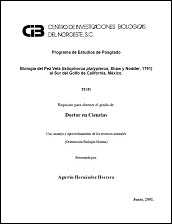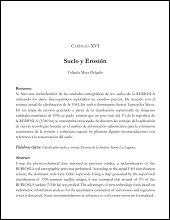Biología floral y estructura poblacional de cardon [Pachycereus pringlei (s. wats.) britton and rose (cactaceae)] en El Comitán, Baja California Sur
Resumen
El cardón (Pachycereus pringlei) es uno de los vegetales característicos de la región sur del Desierto Sonorense. Esta cactácea columnar-arborescente ha sido objeto de investigaciones tendientes a conocer aspectos biológicos y polínicos, tomando como modelo poblaciones del limite norte de su distribución natural, en la costa del estado de Sonora. En esta investigación se aborda la misma temática en poblaciones Sudcalifornianas, casi en el limite sur de su distribución natural donde las condiciones ecológicas son un tanto diferentes a las ya estudiadas. Los objetivo fueron describir procesos biológicos importantes llevados a cabo durante la fase reproductiva del cardón y determinar la estructura poblacional presente, estimando la frecuencia relativa de sexos además de la productividad floral. Esta investigación se llevó a cabo en 1.5 ha de terreno en El Comitán, cerca de la ciudad de La Paz, durante el año 2002. Datos demográficos de la especie indican una densidad poblacional 288 ind/ha, de los cuales solo 32.4 % se consideran maduros o con posibilidades de participar en la reproducción de la especie, el resto de los individuos comprenden plántulas, juveniles e inmaduros. AL definir la estructura poblacional, se determinó que existen grupos de individuos compartinendo características morfológicas en común, diferenciándose entre ellos por a la altura, ramificación y madurez. Se determinó que la población cuenta con 783brazos/ha, de los cuales el 34.3 % son maduros, 45.2 inmaduros y 20.4 presentan algún daño físico. Se determinó que para el año de estudio el 37.1 % de los individuos son masculinos, 36.4 % son femeninos 2.9 % son hermafroditas y el 23.6 % son individuos que se encontraban en Alternancia de Producción. Considerando a la población como trióica, formando parte de un patrón latitudinal descrito para la Península de Baja California. Al determinar la expresión sexual de los cardones se diagnosticó un grupo de individuos con características florales distintas a masculinas femeninas y hermafroditas, fueron llamadas Hermafroditas con Esterilidad Parcial Femenina (HEPF). De los cardones que florearon en el área de estudio el 29 % corresponde a esta nueva expresión sexual, superando al 19.6 de los propiamente masculinos. Sin embargo los individuos HEPF fueron considerados masculinos dada la funcionalidad determinada en sus flores [...] The cardon (Pachycereus pringlei) is one of the characteristic plants of Southern Sonoran Desert. This columnar cactus has been object of investigations, mainly about its biological and pollination aspects, on populations at the northern limits of its natural distribution, in the coast of Sonora State. The thematic on this research is approached in the same way, but the population studied, is located at the southern limits of its natural distribution, Baja California, where the ecological conditions somehow differ from the ones already studied. The objective was to describe important biological processes that take place during the reproductive phase of the cardon, and to determine the present population structure and the relative frequency of sexes in addition to the floral productivity. This investigation was carried out in 1.5 ha of desert in El Comitán, near La Paz city, during 2002. Demographic data of the specie indicates a population density of 288 ind/ha, only 32.4 % is considered mature or with possibilities to participate in the reproduction of the species, the rest of the individuals include seedling, young and immature plants. With the structural characterization, there were assessed groups of individuals that share morphological characteristics in common, being different from the others, with respect to the height, ramification and maturity. An average of 783 arms/ha was counted, from which 34.3 % were mature, 45.2 % immature and 20.4 % present physical damage. In 2002 37.1 % of the mature individuals were males, 36.4 % females 2.9 % hermaphrodites and 23.6 % were individuals that were in alternate production (the sampling year did not bloom). The population was considered trioecious, this finding agrees with the latitudinal pattern described for the Peninsula of Baja California. When determining the sexual expression of the cardons, a group of individuals with floral characteristics different from male, female and hermaphrodites was found, they were named Hermaphrodites with Female Partial Sterility (HFME). From the total of cardons flowering in the study area, 29 % corresponds to this new sexual expression (HFME) surpassing the 19.6 % that males present. Nevertheless HFME individuals were considered masculine given the male functionality of their flowers [...]
Colecciones
Ítems relacionados
Mostrando ítems relacionados por Título, autor o materia.
-
PROMOCIÓN DEL PERIFITON PARA EL CULTIVO DE CAMARÓN BLANCO: HACIA UNA ACUICULTURA ECOLÓGICA
DOMENICO VOLTOLINA LOBINA; JUAN MANUEL AUDELO NARANJO; MARIA DEL ROSARIO PACHECO MARGES -
Suelo y Erosión
YOLANDA LOURDES MAYA DELGADO


